Perhaps this is not totally relevant to this discussion, I'm not sure, but just to show what I have found regarding using high BL high fs drivers in a , well... a really open baffle 
Martinsson's Blog - new place - new refinements of madness
There is an EQ involved here, 12dB boost @ 30Hz along with some node reductions at 63, 160 and 200 Hz all -6dB, no series resistance applied.
It digs deep, 30Hz flat according to my PAA2, providing punch and tonal clarity way beyond my expectations, and it also seems quite sensitive as well (same gain as for the top system).
I'll be sure to try some series resistance within short hoping it might reduce or even eliminate the need for the present EQ settings.
Martinsson's Blog - new place - new refinements of madness
There is an EQ involved here, 12dB boost @ 30Hz along with some node reductions at 63, 160 and 200 Hz all -6dB, no series resistance applied.
It digs deep, 30Hz flat according to my PAA2, providing punch and tonal clarity way beyond my expectations, and it also seems quite sensitive as well (same gain as for the top system).
I'll be sure to try some series resistance within short hoping it might reduce or even eliminate the need for the present EQ settings.
If we compare at 2.83V we can look at both the dual 8ohm with coils in parallel (green), the dual 16ohm with coils in parallel (magenta) and the 15NW100 (lt blue). In no case is the 15NW100 going to ever be more efficient down low than the Dipole15.
1 watt is not 2,83 volts over 89,3795 ohm. You keep comparing at a fixed voltage.
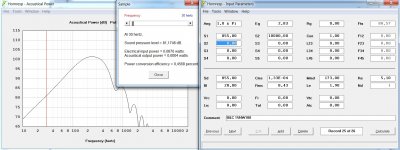
2,83 volts @ 30 Hz into a B&C 15NW100 is 0,087 watts. And with a small fraction of a watt you still get 81,1748 dB sound pressure from a 15NW100 in a 1 m2 open baffle according to Hornresp. If Hornresp is flawed in simulating open baffles it will at least be consistent in the flaw regardless of driver.
We don´t have to take these numbers as absolutes. They are just comparison of different drivers.
Yes you are right in that high Bl, low Qes drivers have a much higher impedans. You can´t ignore this fact when comparing efficiency. Please measure/simulate at 1,0 watts. Not 2,83 volts into a nominal 8 ohm driver.
To get 95dB at 30hz then requires 50W input to the B&C
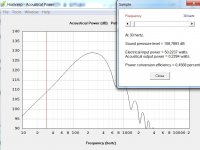
No. This is completely wrong.
50 watts @ 30 Hz into a B&C 15NW100 in an 1,0 m2 open baffle at one meter distance will give 108 dB sound pressure. t takes 68 volts over the speaker terminals to get 50 watts at 30 Hz.
Cheers
Johannes
The big issue with series resistance is that adding it causes a significant loss in overall efficiency everywhere
I don´t mean that anybody should use high power resistors in series with their speakers. That is a good way to try the idea of current drive without special amps, but very lossy and inefficient. The exact opposite of what i want to achieve.
Variable Amplifier Impedance
It is much better to modify an existing suitable amp or diy our own.
A high output impedance does not lower efficiency, but it will almost always lower distortion substantially.
Perhaps this is not totally relevant to this discussion, I'm not sure, but just to show what I have found regarding using high BL high fs drivers in a , well... a really open baffle
Thanks Martinsson!
I have heard these drivers powered by a small mp3 player. We must have really pushed them hard with all those mighty 50 mW of power.
I know they can actually play bas in a large open apartment driven by a mp3 player. I guess the 120 ohm output impedance of the mp3 player helped.
Cheers,
Johannes
1 watt is not 2,83 volts over 89,3795 ohm. You keep comparing at a fixed voltage.
View attachment 466192
2,83 volts @ 30 Hz into a B&C 15NW100 is 0,087 watts. And with a small fraction of a watt you still get 81,1748 dB sound pressure from a 15NW100 in a 1 m2 open baffle according to Hornresp. If Hornresp is flawed in simulating open baffles it will at least be consistent in the flaw regardless of driver.
We don´t have to take these numbers as absolutes. They are just comparison of different drivers.
Yes you are right in that high Bl, low Qes drivers have a much higher impedans. You can´t ignore this fact when comparing efficiency. Please measure/simulate at 1,0 watts. Not 2,83 volts into a nominal 8 ohm driver.
View attachment 466198
No. This is completely wrong.
50 watts @ 30 Hz into a B&C 15NW100 in an 1,0 m2 open baffle at one meter distance will give 108 dB sound pressure. t takes 68 volts over the speaker terminals to get 50 watts at 30 Hz.
Cheers
Johannes
I do realize what you are trying to do here. However, 99% of all amplifiers are not pure current drive so what you are claiming would not apply. That would only work for very rare cases, and not many that the average user would have access to. Even if that was the case, there is not enough displacement to provide what you are simulating.
The best thing to do here is to get a quick sanity check. We can never have more output with an open baffle than on in infinite baffle due to the baffle cancellation. Modelling the 15WN100 on an infinite baffle with 50W input power gives 98dB at 30hz. Factoring in the baffle loss gives much less output in on an open baffle.

In fact the maximum output at 30hz at the 9mm Xmax based on displacement of the driver is 105dB. This is with 300W input. There is no possibility that a baffle with a significantly more rolloff will be close to this point, much less 3dB higher. There isn't enough displacement even in multiple drivers. I am sorry and mean no disrespect, but what you are modelling simply does not come close to reality.
Both ABCDipole and The Edge model quite similarly. These will give real world results that have been verified. In reality there is a slight shift between them and measured results should fit somewhere in between.
Last edited:
One final simulation of the Dipole15-D16 with coils in parallel for 8ohm nominal. This time using Basta! which I will be using much more in the future. Again Dipole15 in green and 15NW100 in red. Unless you are hooking to a pure current drive source, these multiple models are quite accurate for 99% of systems out there.
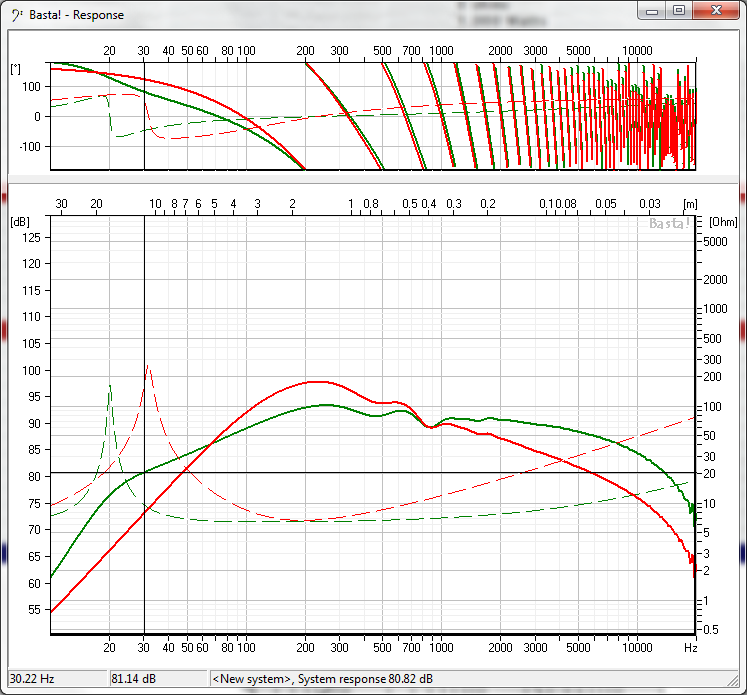

I do realize what you are trying to do here. However, 99% of all amplifiers are not pure current drive so what you are claiming would not apply.
If 99% of all the amps where current drive (low damping factor) it would still not change the fact that the 15NW100 is a more efficient driver above 30 Hz compared to the AE Dipole 15 in a open baffle.
It is not dB/2,83 volts, as that is just as random as saying dB/2 meters distance. It is always spl för voltage times current.
EQ is just as effective in increasing voltage. It does not have to be current drive, but since current drive has additional advantages compared to heavily EQed voltage drive amps, that is what i prefer.
Your simulations does not prove anything, since they lack data. Please show efficiency or both voltage and current for a given spl.
In fact the maximum output at 30hz at the 9mm Xmax based on displacement of the driver is 105dB. This is with 300W input
I only simulated your suggested power level (50 watts at 30 Hz). I know both drivers lack xmax för 108 dB at 30 Hz. How do you get "300W input", when i clearly show 50 watts in my hornresp sim? "Watt" is still V X A, or do you have another definition?
The best thing to do here is to get a quick sanity check. We can never have more output with an open baffle than on in infinite baffle due to the baffle cancellation. Modelling the 15WN100 on an infinite baffle with 50W input power gives 98dB at 30hz
A quick sanity-check is a good thing.
The same 50 watts into a B&C 15NW100. I choose a 5000 liter box since Hornresp does not do infinite sized boxes. Since it is many times larger then Vas, i think it is close enough.
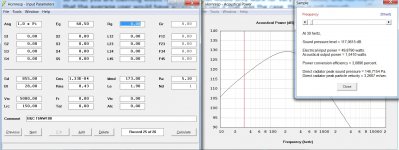
In 1,0 pi radiating angle (against back wall and floor) it would give 117 dB spl level at 30 Hz, if it had 17,33 mm xmax. It does not, but Dipol15 does not either.
Where do you find 300 watts in this example?
There isn't enough displacement even in multiple drivers.
Now i am really confused?
Can you please explain this a little better?
With a nebulous "multiple drivers" i can build a 130 dB @ 30 Hz capable OB with Lowther full range drivers... It is only a matter of quantity.
A quick sanity-check is a good thing.
The same 50 watts into a B&C 15NW100. I choose a 5000 liter box since Hornresp does not do infinite sized boxes. Since it is many times larger then Vas, i think it is close enough.
View attachment 466226
In 1,0 pi radiating angle (against back wall and floor) it would give 117 dB spl level at 30 Hz, if it had 17,33 mm xmax. It does not, but Dipol15 does not either..
First, you have entered 68.5V. You cannot simply put the cursor at 30hz to make the claim of 50W input. 68.5V is around 760W into an 8ohm nominal coil. Secondly, you cannot put an open baffle up against a wall to gain additional loading. Again, you are dealing with severe misconceptions. These things are just completely wrong.
68.5V is around 760W into an 8ohm nominal coil
You can not say "nominal coil" as the impedance is all over the chart on a real loudspeaker. You have to specify what the impedance is where you are simulating/calculating/measuring. Otherwise the voltage is just as interesting as the color of your underwear when you are doing the measurement/simulation/calculation.
Secondly, you cannot put an open baffle up against a wall to gain additional loading
In my experience large open baffles are somewhere between 1,0 pi and 2,0 pi, as they are quite large for the wavelengths they reproduce. 1,0 pi is as wrong as 2,0 pi.
I simulated this next one in 2,0 pi.
9 15NW100 drivers in one 2,25 m2 large open baffle.
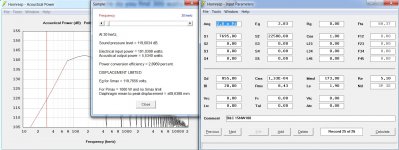
Hornresp might be totally wrong (i seriously doubt it), but i see 119,6 dB spl at 30 Hz with only 191 watts of power.
You will first need a basic understanding of loudspeaker enclosure models. These models have already accounted for the variations of the impedance curve. You cannot then correct for them again as you are suggesting.
In addition, the baffle effects are already accounted for in Basta!, ABC Dipole, etc. You cannot then give additional compensation by adding additional boundaries that do not exist in the system.
These inaccuracies will not give correct results.Quite simply, all of these results can be verified by measurements. All the simulation in the world will mean nothing if real world measurements do not match. The simulations with ABCDipole, Bassbox, Basta! and The Edge are all verifiable by real world measurements. The simulations you are showing are not.
In addition, the baffle effects are already accounted for in Basta!, ABC Dipole, etc. You cannot then give additional compensation by adding additional boundaries that do not exist in the system.
These inaccuracies will not give correct results.Quite simply, all of these results can be verified by measurements. All the simulation in the world will mean nothing if real world measurements do not match. The simulations with ABCDipole, Bassbox, Basta! and The Edge are all verifiable by real world measurements. The simulations you are showing are not.
You can not say "nominal coil" as the impedance is all over the chart on a real loudspeaker. You have to specify what the impedance is where you are simulating/calculating/measuring. Otherwise the voltage is just as interesting as the color of your underwear when you are doing the measurement/simulation/calculation.
Nope, sorry. You give nominal impedance and voltage input, and that tells you how much power the driver is seeing. An 8ohm speaker system might have dips down to 5ohm, and peaks at >40ohm, but if you put 28.3v across it, it'll be dissipating 100w.
Current draw will vary with frequency, of course, but averaged over a reasonably wide bandwidth, this becomes largely irrelevant.
Hornresp might be totally wrong (i seriously doubt it), but i see 119,6 dB spl at 30 Hz with only 191 watts of power.
Okay, what's the power draw at 35Hz?
I'd bet actual money it won't do that SPL at that power input at 35Hz.
If you keep a constant power input and let voltage vary, you'll end up with a very one-note response, since any given speaker is very efficient at resonance.
Most amplifiers work on constant-voltage, and let current (and therefore power) vary by frequency. This gives a flat-ish response, since most drivers are designed to be driven by voltage sources.
You're relying on playing test-tones, in which case, yeah, you need 191w at 35Hz to get a lot of SPL. Music, however, tends to have other frequencies, too. You'll need more power for those since they're not at the resonant frequency of your driver.
Chris
You will first need a basic understanding of loudspeaker enclosure models
I have.
These models have already accounted for the variations of the impedance curve. You cannot then correct for them again as you are suggesting.
Then what is Hornresp doing? I only input voltage and hit "Calculate". The results comes from Hornresp. I don´t do anything else. I don´t correct anything. I just read. Maybe you should learn more about Hornresp? (I mean no disrespect)
Okay, what's the power draw at 35Hz?
I'd bet actual money it won't do that SPL at that power input at 35Hz.
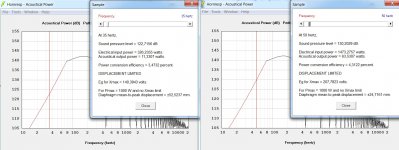
Same sim as in previous post. 2,0 pi. 9 drivers. 2,25 m2 open baffle.
Cheers,
Johannes
An 8ohm speaker system might have dips down to 5ohm, and peaks at >40ohm, but if you put 28.3v across it, it'll be dissipating 100w
28,3 v X 28,3 v / 40 ohm = 100 watt???
I get 20,02225 watts, but i guess calculators are different in different parts of the world...
Current draw will vary with frequency, of course, but averaged over a reasonably wide bandwidth, this becomes largely irrelevant.
If you change "irrelevant" to "less important" it is much nearer some kind of truth. Especially so in the midrange and treble.
Big bass drivers does have to varying impedance for that statement to be true.
28,3 v X 28,3 v / 40 ohm = 100 watt???
I get 20,02225 watts, but i guess calculators are different in different parts of the world...

Play 100w noise. Your amplifier will put out 28.3v RMS and your speaker will dissipate ~99w of heat and put out the other 1w as sound. (Okay, might be 95w and 5w, depending on your conversion efficiency).
To reiterate, this is for broad-band noise. You're only talking about effects that happen over a very narrow frequency range.
Your most-recently attached simulation shows what I'm talking about - at 50Hz you're hitting it with nearly 1.5kW, to keep the 50Hz response ~as loud as the 35Hz response.
Chris
I made the mistake of buying a Chinese copy of a JBL 2268; when tested was way off spec’s, Too boomy to use in reflex cabinet, even with high damping factor amps.
How would it go in an open baffle?
I Could use it with a tube amp with internal resistance of 10 Ohms.
Jbl Chinese 2268
Vas = 10 ft3
fs = 33 Hz
Qts = 0.725 Should have been 0.33
D = 18 in
Sensitivity 94Db
Phil
How would it go in an open baffle?
I Could use it with a tube amp with internal resistance of 10 Ohms.
Jbl Chinese 2268
Vas = 10 ft3
fs = 33 Hz
Qts = 0.725 Should have been 0.33
D = 18 in
Sensitivity 94Db
Phil
Thanks for the very educational information John. It is the reason I love coming to this forum. I've been wanting to go the route of open baffle for my bass but drivers like the Eminance Alpha just don't seem to cut it. I thought I'd simply end up using conventional subs for my OB line array but the Dipole 15 looks very promising.
-Rob
-Rob
to OP:
My suggestions:
1. Sd: 15" is a good choice. Add more drivers for more output requirement, don't go bigger woofer. (I'm using 18", I wish they are 15")
2. Xmax: larger is better
3. fs: lower is better (but 30-some is good enough)
4. power: not important, choose the smallest one in the series. You'll get lighter cone and smaller VC, it's better for home use hi-fi. OB speaker is stroke limited, not power.
5. Qts: not important, or don't limit yourself because of this. Many good drivers out there. You'll wipe out most of the choices if you insist on high Qts. Eventually, it's important to get 'system Q' instead of driver's Q. (high impedance driving is already mentioned above, it's good)
Dipole loss is unavoidable. It'd be better to spread EQ requirement to several 'stages' - Q set by driver & amp, line level, digital... etc. The concept is in common with gain structure.
6. For bass purpose, don't use the woofer in plain/flat OB. I like to have them slot-loaded. Other configurations might work, too.
7. Don't try too hard to get them below 30 Hz or so. You'll get more distortion than clean SPL.
Have fun.
My suggestions:
1. Sd: 15" is a good choice. Add more drivers for more output requirement, don't go bigger woofer. (I'm using 18", I wish they are 15")
2. Xmax: larger is better
3. fs: lower is better (but 30-some is good enough)
4. power: not important, choose the smallest one in the series. You'll get lighter cone and smaller VC, it's better for home use hi-fi. OB speaker is stroke limited, not power.
5. Qts: not important, or don't limit yourself because of this. Many good drivers out there. You'll wipe out most of the choices if you insist on high Qts. Eventually, it's important to get 'system Q' instead of driver's Q. (high impedance driving is already mentioned above, it's good)
Dipole loss is unavoidable. It'd be better to spread EQ requirement to several 'stages' - Q set by driver & amp, line level, digital... etc. The concept is in common with gain structure.
6. For bass purpose, don't use the woofer in plain/flat OB. I like to have them slot-loaded. Other configurations might work, too.
7. Don't try too hard to get them below 30 Hz or so. You'll get more distortion than clean SPL.
Have fun.
Last edited:
I made the mistake of buying a Chinese copy of a JBL 2268; when tested was way off spec’s, Too boomy to use in reflex cabinet, even with high damping factor amps.
How would it go in an open baffle?
I Could use it with a tube amp with internal resistance of 10 Ohms.
Jbl Chinese 2268
Vas = 10 ft3
fs = 33 Hz
Qts = 0.725 Should have been 0.33
D = 18 in
Sensitivity 94Db
Phil
If Xmax is ok - that should be a fine OB driver. It's so easy to try. A test baffle can be made in 30 minutes.
Your most-recently attached simulation shows what I'm talking about - at 50Hz you're hitting it with nearly 1.5kW, to keep the 50Hz response ~as loud as the 35Hz response.
Please look again. 1,5 kw is for maximum spl (130 dB, displacement limited). It is the power conversion efficiency that is interesting.
The simulations with ABCDipole, Bassbox, Basta! and The Edge are all verifiable by real world measurements. The simulations you are showing are not
Please mail David J McBean. He needs to know that Hornresp is flawed. That Hornresp simulations is not verifiable by real world measurements. Obviously Ohms law is not applicable for open baffles since you say "68,5v * 68,5v / 84,4079 ohm = 760 watt".
First, you have entered 68.5V. You cannot simply put the cursor at 30hz to make the claim of 50W input. 68.5V is around 760W into an 8ohm nominal coil.
Can you please explain this for me? I tend to see Ohms law as a foundation for designing speakers (among other things).
If we try to use ohms law, and believe in David McBeans Hornresp simulation program, then a B&C 15NW100 is still more efficient then a Dipole15 above 30 Hz. Not compared at 2,83 volts blind for any difference in impedance, since without knowing the current, voltage alone is not relevant.
Cheers,
Johannes
- Status
- This old topic is closed. If you want to reopen this topic, contact a moderator using the "Report Post" button.
- Home
- Loudspeakers
- Multi-Way
- Open Baffle woofer what is important?